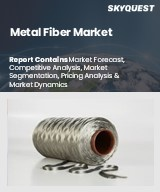
세계의 금속 섬유 시장 규모는 2023년에 54억 달러에 달하며, 예측 기간(2025-2032년)의 CAGR은 4.4%로, 2024년 56억 4,000만 달러에서 2032년까지 79억 6,000만 달러로 성장할 전망입니다.
세계 금속섬유 시장은 자동차, 항공우주, 전자 등 다양한 산업 분야 수요 증가에 힘입어 큰 성장 잠재력을 보이고 있습니다. 금속섬유는 고강도, 내식성, 열전도성 등의 고유한 특성으로 평가받고 있습니다. 첨단 제조 공정의 부상과 경량화 재료의 추진은 복합재료 용도에서 금속 섬유의 채택을 촉진하고 있습니다. 또한 금속 섬유 생산 기술의 혁신으로 성능 특성이 향상되고 비용이 절감되어 다양한 용도에 쉽게 사용할 수 있게 되었습니다. 지속가능성과 재활용에 대한 관심이 높아지면서 업계가 환경 친화적인 재료의 통합을 모색하는 시장 역학도 형성되고 있습니다. 전반적으로 금속 섬유 시장은 범용성과 폭넓은 활용 가능성을 바탕으로 확장할 준비가 되어 있습니다.
Global Metal Fiber Market size was valued at USD 5.4 billion in 2023 and is poised to grow from USD 5.64 billion in 2024 to USD 7.96 billion by 2032, growing at a CAGR of 4.4% during the forecast period (2025-2032).
The global metal fiber market exhibits significant growth potential, driven by increasing demand across various industries including automotive, aerospace, and electronics. Metal fibers are valued for their unique properties, such as high strength, corrosion resistance, and thermal conductivity. The rise in advanced manufacturing processes and the push for lightweight materials are propelling the adoption of metal fibers in composite applications. Additionally, innovations in metal fiber production technologies are enhancing performance characteristics and reducing costs, making them more accessible for a wide range of applications. The growing emphasis on sustainability and recycling is also shaping market dynamics, as industries seek to integrate eco-friendly materials. Overall, the metal fiber market is poised for expansion, supported by its versatility and extensive application possibilities.
Top-down and bottom-up approaches were used to estimate and validate the size of the Global Metal Fiber market and to estimate the size of various other dependent submarkets. The research methodology used to estimate the market size includes the following details: The key players in the market were identified through secondary research, and their market shares in the respective regions were determined through primary and secondary research. This entire procedure includes the study of the annual and financial reports of the top market players and extensive interviews for key insights from industry leaders such as CEOs, VPs, directors, and marketing executives. All percentage shares split, and breakdowns were determined using secondary sources and verified through Primary sources. All possible parameters that affect the markets covered in this research study have been accounted for, viewed in extensive detail, verified through primary research, and analyzed to get the final quantitative and qualitative data.
Global Metal Fiber Market Segments Analysis
Global Metal Fiber Market is segmented by Product, Technology, Application, End-Use and region. Based on Product, the market is segmented into Steel, Nickel, Copper, Aluminum and Others. Based on Technology, the market is segmented into Bundle Drawing, Foil Shaving, Machining and Melt Spinning. Based on Application, the market is segmented into ESD/EMI Protection, Filtration, Hot Glass Manipulation, Electrical Cables, Specialties and Others. Based on End-Use, the market is segmented into Textile, Automotive, Aerospace, Power & Electronics and Others. Based on region, the market is segmented into North America, Europe, Asia Pacific, Latin America and Middle East & Africa.
Driver of the Global Metal Fiber Market
The Global Metal Fiber market is experiencing significant growth driven by the automotive and aerospace sectors that are embracing metal fibers for their impressive strength and lightweight properties. These characteristics are essential for high-performance aircraft and fuel-efficient vehicles. As industries continue to prioritize sustainability and safety, the demand for advanced materials like metal fibers is on the rise. This heightened focus on reducing carbon emissions while enhancing vehicle performance is fueling the expansion of the market, showcasing the critical role that metal fibers play in meeting evolving industry standards and consumer expectations for efficiency and safety.
Restraints in the Global Metal Fiber Market
The Global Metal Fiber market faces certain restraints largely due to the complex and specialized manufacturing processes involved in producing these fibers, such as drawing and extrusion. These methods require not only advanced equipment but also skilled expertise, leading to elevated production costs. The reliance on high-quality raw materials further exacerbates these expenses. As a result, manufacturers may struggle to balance quality and affordability, creating challenges in penetrating markets with limited financial resources. This situation may restrict the broader application of metal fibers, particularly in sectors where budget constraints hinder investment in such advanced material solutions.
Market Trends of the Global Metal Fiber Market
The Global Metal Fiber market is witnessing a significant trend towards eco-friendly and lightweight materials, driven by increasing sustainability demands across various industries, particularly in construction and automotive sectors. As companies prioritize minimizing their environmental footprints, there is a growing preference for metal fibers, which provide a favorable alternative due to their reduced weight and enhanced strength compared to traditional materials. This trend is further propelled by the necessity for improved fuel efficiency and lower energy consumption, aligning with global efforts to promote greener practices. Consequently, the market is anticipated to expand robustly, as innovation in metal fiber applications continues to evolve.